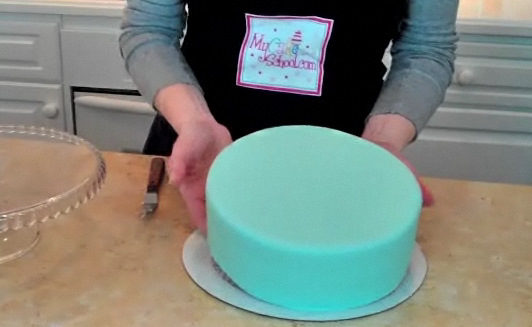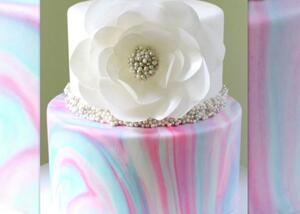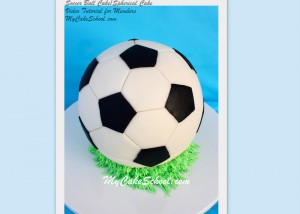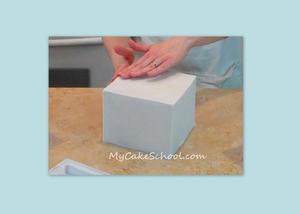Covering Cakes with Fondant- A Cake Decorating Video Tutorial
In this cake video tutorial, I'll show you the basics of covering a cake with fondant.
Fondant is an edible sugar dough that is used all over the world to create beautiful cakes with a smooth finish.
Table of Contents
What Type of Fondant is Best?
There are many different opinions on the best brands or recipes of fondant.
Satin Ice and Wilton are good options and are not too expensive.
I use Liz Marek's recipe most often which is a combination of pre-made fondant and marshmallow fondant. You can find the link HERE. (I love it because it is more elastic, tastes like marshmallows, and I never have issues with elephant skin or tearing.
In this video, I cover my settled, buttercream crumb-coated cake with fondant rolled approx. ⅛" thick. I applied my buttercream slightly thicker than a usual crumb coat. Apply your frosting just thick enough to make the cake surface nice and smooth.
Using Ganache Beneath Fondant
You do not have to use buttercream beneath the fondant. In fact, many decorators prefer to use ganache frosting which is firmer and less likely to bulge.
Hop over if you'd like to see my Spreadable Ganache recipe in the Recipes section. It creates a really nice, sturdy foundation for fondant.
Steps for Covering Cakes with Fondant
Chilling the Cake
First, I like to place the frosted cake in the freezer for about 15-20 minutes just before covering with fondant. Chill until the frosting is nice and firm. If you skip this step, the frosting with shift as you apply the fondant.
Condensation
If you leave the cake in the freezer for too long (an hour or more), you will likely have condensation after applying the fondant.
You just want the outer layer of the cake to be chilled and firm when applying the fondant. However, if this happens to you, don't touch the fondant. Place the cake in front of a fan and the moisture will evaporate over time.
Rolling out the Fondant
While the cake is chilling, you can roll out your fondant. First, lightly grease the counter with a very thin layer of vegetable shortening. (Some decorators use a dusting of cornstarch or powdered sugar instead but I prefer shortening unless my fondant is very, very soft).
Roll the fondant to about ⅛ inch thickness (or less).
Covering the Cake
Remove the cake from the freezer.
Preparing the tier for fondant: I find that fondant adheres well to the chilled buttercream or ganache. If your crusted buttercream or your ganached cake seems too dry for fondant to adhere, mist it with a tiny bit of water or rub with a very thin layer of shortening.
Roll the fondant up onto a long rolling pin. (If it sticks to itself, you can dust it with a bit of powdered sugar.)
Unroll the fondant over the cake and then smooth the top and around the top edge of the cake first. This will keep the fondant from pulling down and tearing.
Then, work you way down around the sides. When the fondant wrinkles, just fluff/gently pull the fondant slightly away from the cake and go back in again, smoothing it around the sides.
Finally, trim away the excess with a pizza cutter or xacto knife.
More Fondant Cake Tutorials
We have other fondant tutorials that you may find helpful.
- Here is our tutorial on how to create and cover a cake with Marbled Fondant
Here is a tutorial on How to create and cover a ball/spherical shaped cake with fondant
In our Sledding Snowman Cake, you will see how I cover a spiral carved cake tier with fondant.
Here, we covered our Topsy Turvy Cake in fondant
And finally, How to Cover a Square Cake with Fondant
Enjoy the video!
We hope that you enjoy this quick video on covering cakes with fondant. You will notice that this is one of our older videos ;0)
We do plan to redo some of these oldies but until then-- the information and process has not changed over the years. I hope that you find it helpful!







Thanks Melissa! One more question. I did a practice cake - and ended up with elephant skin. What is the cause? How do I prevent and/or fix on my future cake?
To clarify - I used The Mat...but hadn't used The Mat (Sweetwise version) in several years, so maybe I should have oiled the inside? My fondant smoother tool seemed to not "glide" across the surface of the cake, so I first tried powdered sugar - which made things more sticky. Then I used corn starch - which worked like a gem. Maybe I used too much corn starch????
Thanks in advance on your prompt reply
Last question, observation.... I also noticed when I pulled out my Mat that it was somewhat wavy (no creases, just wavy from being in the tube unused for so long I guess). At any rate, I used the mat anyway, and things were "okay" (minus the elephant skin in a couple of places). Is there a way to fix my waves? I hate to buy another mat....Could I lay it out on a flat surface with books weighting it down for a few days?
Hi Karen, it could be that your fondant is a little dry. You could knead in a little shortening. I also like to roll out my fondant on a surface that has been prepared with a light coating of shortening rather than a surface powdered with corn starch or powdered sugar. -- Kneading in a little glycerine is probably my favorite way of restoring moisture to fondant that is on the dry side.
**I used to occasionally get elephant skin even with my favorite brands of pre-made fondant. However, a couple of years ago I tried Liz Marek's recipe (which is a combination of marshmallow fondant and Wilton pre made). Now we use it almost exclusively. I've never had elephant skin with this recipe & it is my favorite to work with. Here is a link to her recipe, I would definitely give it a try if you haven't already. (It tastes good too!)
Karen, I posted before seeing your followup questions! ;0) -
Now I see that you are using the mat. I suppose that dusting your fondant/smoother with corn starch could have a drying effect on your fondant although I do that sometimes also when the fondant doesn't easily smooth. I still think that your fondant may have been a bit on the dry side to begin with. Sometimes if my smoothed fondant looks a little iffy, especially around the corners, I rub a bit of shortening on it so that it absorbs & moisturizes ;0) . This prevents cracking.
As for your warped mat, I think that the best bet is to contact SweetWise's customer service which has always been good in my experience. They may have some tips for you on taking the waves out. Good luck!
Hi´
In Denmark we don´t have this kind of shortening as you use. Can you tell me an alternative? Can one use coconut fat or oil in the fondant to prevent cracks and dryness?
Thank you
Kristina
Hi Kristina, I have read that in Denmark Palmin is a shortening you can use. If you try this product, let us know if that is a good solution for you.
Thank you - I´ll try that
Hi, I was doing the covering cakes with fondant, well trying to, And it kept ripping. What should I do??
-
I crumb coated my cakes last night( two tier cake ), let them settle. Today I took them out of fridge to ice but, got a call and they don't want it until Sunday morning instead of Sat! I don't want to put the fondant on and stack until late Sat. Can I put the cakes wrapped back into the fridge?
Hi Melissa/ Bebe how much fondant do you recommend to get a decent covering on an 8" cake and a 6" cake
Hi Melissa, I have a question. I bake my cakes wrap them and put in refrigerator until next day. I take them out crumb coat and put back in refrigerator to let them settle. The next day take out icing while cold. Put fondant on looks beautiful. When I wake up the next day, it splits or have large air pockets. Can you tell me what I’m doing wrong. Thank you in advance.